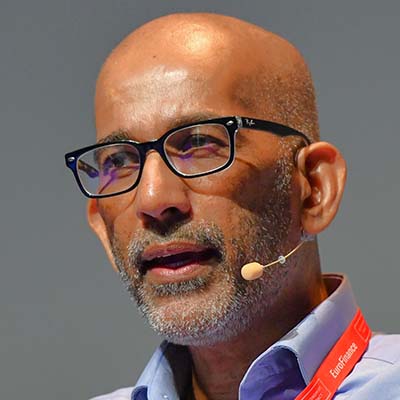

- Ben Poole
- Editorial Team, Treasury Management International (TMI)

- Royston Da Costa
- Assistant Group Treasurer, Ferguson plc

- Ulrika Haug
- Senior Director, Coupa Software
One silver lining from the Covid-19 pandemic is that it has supercharged trends around treasury technology – both in the adoption of new technology by corporates and the development of cutting-edge technologies that will have treasury applications in the coming years. During a recent webinar, TMI’s Editor, Eleanor Hill, spoke with Royston Da Costa, Assistant Group Treasurer at Ferguson, and Ulrika Haug, Senior Director, Product Marketing at Coupa, to explore how these trends have impacted finance and what it all means for the future of treasury.
As 2022 continues to speed by, and many countries around the world are cautiously learning to ‘live with Covid’, the extent to which the pandemic changed the importance of technology within treasury and accelerated tech adoption is becoming clear.
Coupa’s Haug comments: “The pandemic has served as a catalyst to accelerate digital transformation. Many of us were forced into an increasingly remote work environment, which exacerbated some of the flaws in processes that corporates perhaps didn’t realise existed. Very manual, time-consuming and labour-intensive processes don’t go well if we work remotely. That has highlighted the need for digital transformation and for everyone to be operating from one single source of truth.”
Da Costa agrees that the impact of the pandemic has been quite significant on treasury: “Cashflow forecasting has always been in the top five priorities for any treasurer, but since the pandemic began it has been the top priority – as seen in many industry surveys,” he notes. “If you look at a silver lining from the pandemic, some technology implementations have been accelerated, and we also saw a breaking down of silos within companies. The health crisis also brought various department stakeholders together to discuss what companies needed to get right for the business to move forward.”
Turning to his own organisation, Da Costa explains that most of the systems used by Ferguson’s treasury are cloud-based, enabling the normal processes to operate largely unhindered even when some remote working was required. Interestingly, Da Costa also found that the pandemic changed how some banks approached digital versus paper documents.
“Up until Covid-19, the banks we dealt with refused to accept digitised documents,” recalls Da Costa. “Then, literally the day after we went into lockdown, the banks were suddenly ok with Adobe Sign and other digital approvals.” This is an example of how big and unexpected events can make people in the treasury space more open-minded to leveraging emerging technologies.
Regulation is another driver for this, as demonstrated by recent examples such as PSD2 or open banking. That change of heart can also come from a strategic shift within the business.
“A change in the board can alter the culture around technology within an organisation,” says Da Costa. “When we had a new CFO come onboard in 2010, he wanted to focus on automating treasury processes. But that culture change is also being driven by the new generation coming into the treasury workplace. They have an expectation of what they would like to interact with, and digital technology is the standard for them.”
Untangling treasury processes through quantum computing
With this ‘expectation’ in mind, before the webinar, TMI polled treasurers about the technological developments they are most curious about, with a choice of four options: quantum computing, blockchain, the metaverse and community intelligence. Interestingly, quantum computing attracted over a quarter (26%) of the votes.
“I view quantum computing as a successor to blockchain because it’s so much more powerful,” comments Da Costa. “But it’s not something we will have access to in the near future as it’s so expensive. There are already some third-party providers out there with solutions that show where this might be able to help treasurers.”
Da Costa shared the example of a company called AlgoDynamix, a financial forecasting company that covers a range of asset classes, including crypto, equities, and commodities. They have a quantum computing-based solution to help companies hedge their FX rates and almost predict what these FX rates are going to be in the future. “There are no guarantees in life, but it reduces the uncertainty we currently face when looking at hedging,” he notes.
Quantum computing could become essential in treasury for anything that requires a massive amount of data and processing, according to Coupa’s Haug. “The true power of quantum computing is in the speed with which it can process data, especially when it comes to very complex algorithms and processes, taking all that massive volume and data and immediately providing you with the insights,” Haug says. “I definitely see an application there when it comes to forecasting, and particularly when it comes to hedging.”
Blockchain appeal lingers for treasurers
As game-changing as quantum computing might be for treasurers in the coming years, blockchain topped the audience poll, with 42% still curious about the technology that corporates have been hearing about for quite some time.
“When I first came across blockchain six years ago, I was very excited by the concept and the technology,” comments Da Costa. “I deliberately steered clear of the related topic of cryptocurrency because it wasn’t evolved, and it still hasn’t evolved sufficiently for it to be mainstream. But the underlying technology, blockchain or DLT, is still an important technology.”
Separating the potential of the technology from the cryptocurrencies that ushered it into the spotlight is still somewhat of a challenge all these years later. Yet the potential for blockchain to transform specific treasury processes is evident. Blockchain is an immutable public distributed ledger that anyone can read or write. For corporate treasurers, this immediately resonates with duties such as KYC, payments, or anything else that needs to be managed securely.
“As a treasurer, you want to focus on something reliable, and the challenge with some cryptocurrencies is they are volatile,” adds Da Costa. “That said, there’s no question that they are starting to have an impact, particularly in the retail sector, and NFTs are popping up too. Stablecoins may offer an answer in this space, as they are tied to normal fiat currencies that are less volatile than cryptocurrencies.”
Coupa’s Haug agrees with Da Costa’s point that treasurers cannot simply ignore cryptocurrencies anymore and notes the challenges in this space: “Bitcoin is actually illegal in about 40-plus countries,” she comments. “Given that, until there’s a greater standard and greater clarity on exactly what that standard is, cryptocurrency will likely be adopted more quickly in certain regions, and maybe not adopted at all in others.”
Breaking down silos with community AI
Meanwhile, AI is a technology that treasurers are fairly familiar with today, even if they are not directly using it, as many of the tools available from cloud-based treasury technology will include some level of AI or machine learning. These algorithms learn over time based on pattern recognition of data sets, enabling them to predict X and Y outcomes. One of the latest trends in this space is something called community AI.
“Community AI is all about taking a step back and breaking down silos,” explains Haug. “You can achieve visibility by having one integrated process – from sourcing, procure-to-pay, payments, and up to settlement and reconciliation. That’s where treasury comes in.”
Community AI will look at that complete end-to-end process and all of the transactional data that is produced during that process, whether it’s with suppliers, beneficiaries, or banks, and analyse the different patterns. It is all about pattern recognition in terms of risk and how it translates into various risk profiles.
“The key is to have a proper data management structure in place,” continues Haug. “It’s quite difficult to do unless you’re somehow integrating and connecting all the data together. We typically see corporates with disparate sets of data sitting in different systems, so not only are the organisations siloed but the systems themselves are siloed so they don’t have that visibility. If you can create a data management infrastructure where there’s a single source of truth, that’s where you can really leverage the power of community intelligence or community AI, to produce those insights for these applications such as risk management.”
Turning virtual benefits into reality
Another area of technological development which could have some fascinating implications for corporate treasurers is the creation of virtual worlds and how these could be used to model different effects in the real world. One prominent example of this is something known as ‘digital twins’.
“The concept of digital twins revolves around looking at technologies already out there, such as virtual reality tools or the metaverse, and applying them to the real world,” Da Costa explains. “For example, you could take a digital replica of a city, or something smaller like a bridge, and then apply all the real factors that would impact that, such as weather, stress testing, accidents, etc. It gives the opportunity to effectively forecast what you can expect to happen in a certain situation.”
This type of scenario planning in a virtual world to prepare for real-life events could have been a potent tool before the Covid-19 pandemic. Companies could have had a better idea about just what might happen and how quickly it could impact all areas of their business.
“I like the digital twins concept because it looks at live data,” affirms Da Costa. “If you apply that to a treasury scenario, many companies were caught short by the pandemic, they didn’t anticipate and quickly provide everything that their employees needed to work from homes, for example. If you’ve got the technology to identify all of that at a glance, it’s hugely powerful.”
One of the more headline-grabbing virtual developments in recent years has been the growth of the metaverse. A recent report by Citi suggests that the metaverse economy could reach $13tr. by 2030. Clearly, this has resonated with corporate treasurers, as nearly a quarter of those polled (23%) identified this as the tech development that they are most curious about. Essentially, the metaverse is a network of virtual worlds where people can connect with each other through 3D virtual interaction, holograms and more.
“With the metaverse, you could effectively be in the same office as a colleague halfway around the world,” comments Da Costa. “For example, I’m based in the UK while some of my colleagues are based in the US. With the metaverse, we could be in the same meeting room as they are, at the same virtual table. It’s going to enhance interaction. This is another example of technology being accelerated by the pandemic.”
To experience some of these benefits that the metaverse can potentially offer corporate treasurers, hardware such as augmented reality glasses or virtual reality headsets could become essential pieces of kit. The latest versions of these types of eyewear can help the wearer by overlaying additional data sets onto the real world to help inform decision-making. A building inspector, for example, could overlay blueprints onto a real bricks and mortar building using this technology. This would allow them to check that every single beam has been put in the right place and to dig down and identify whether the right bolt, nut, or rivet has been used, to the nth degree. This type of technology could also be applied to treasury management.
“To put that type of virtual reality into a treasury context, you can easily apply it to any strategy or a programme you might have,” says Da Costa. “Hedging springs to mind because that’s known to all of us. Forecasting too – you’d have your rules and parameters overlaid by what you’d put in place, which would quickly identify wherever you need to change something.”
Applying technology to treasury
How corporates can and will future-proof their treasury function goes hand in hand with technology. It is vital to have a roadmap and ensure that the team is being trained and developed with a close eye on what technology is out today and what is coming up.
“I think diversity, inclusion and wellbeing are also essential for any team today, and if there’s one lesson that this pandemic has taught us, it is about collaboration at a human level,” says Da Costa. “For example, at the height of the pandemic, we were getting daily feedback on how our customers were doing, not just in terms of paying us but also literally how they were doing in terms of wellbeing, which was important for a number of reasons.”
Haug agrees that the role of the treasurer has evolved with the pandemic: “Playing that strategic side of the role has highlighted the importance of treasury. One of the things we’ve seen, where technology is a great enabler, is communicating financial and business metrics effectively and quickly to stakeholders, whether that’s IT, a line of business, or even the CFO or CEO.”
Treasury technology and transformation takeaways
As is clear from this whistle-stop tour around just some of the technologies that treasurers could be using any time from today to a few years’ time, there is a lot to unpack around how these technologies work and what impact they could have on treasury management. It could appear daunting to some, but Coupa’s Haug underlines the positives to take from these developments.
“Digital transformation is accelerating exponentially, so treasurers need to make smart decisions about where you’re investing in terms of those technologies,” she says. “Do your due diligence, and really be open to this transformation.”
She adds that when evaluating technologies, it can pay to take a holistic approach and explore how to break down silos. Treasurers need to understand their own trajectory and be open to what colleagues in areas such as FP&A and procurement are doing. “Looking at the entire end-to-end process is critical, rather than just solving for one symptom, as that might create a blind spot elsewhere along the process. Instead, take a holistic approach,” advises Haug. “Treasurers can also play a strategic role in explaining to different business stakeholders why technology is important and what the business case is.”
The message of collaboration with business partners is echoed by Da Costa, who provides an example of how his treasury team had used this approach on a technology project.
“When we implemented with Coupa, we put a presentation together to show all the major stakeholders, including audit, group finance, and senior management, what they could achieve,” he recalls. “We fine-tuned this to each of those teams, to show what benefits they would realise, in areas such as internal audit, IT, and security.”
Finally, he stresses that treasurers should not be over-infatuated with all new technologies but rather focus on where these breakthroughs can help them to fix deficiencies in their processes. “You’ve got to try and visualise how this technology or solution will benefit your business, so it’s important to have a requirement,” concludes Da Costa. “Don’t try and solve a problem that doesn’t exist.”



